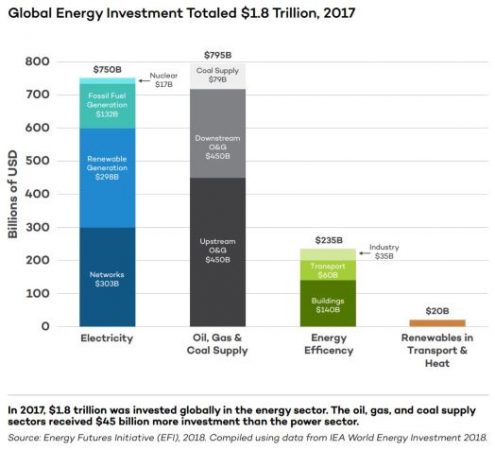Report Urges using Nuclear Energy for Clean Energy Ecosystem in US
A report commissioned by the Breakthrough Institute and prepared by consulting group IHS Markit and the non-profit Energy Futures Initiative makes a case for nuclear energy to ensure the US maintains its clean energy leadership

Former US Secretary of Energy and Energy Futures Initiative founder Ernest Moniz and IHS Markit vice chairman Daniel Yergin released a report called ‘Advancing the Landscape of Clean Energy Innovation’ which seeks to provide ‘objective’ review of the current clean energy innovation ecosystem, including identifying strengths and weaknesses of each of the following technological innovation spheres under review.
From this broad list, the report identifies 10 high-priority clean energy innovation areas:
-Storage and battery technologies
-Advanced nuclear reactors
-Hydrogen
-Advanced manufacturing technologies
-Building energy technologies
-Electric grid modernization and smart cities
-Large-scale carbon management
-Carbon capture, use and storage
-Sunlight to fuels
-Biological sequestration
The report uses a four-step methodology – focusing on technical merit, potential market viability, compatibility with other elements of the energy system, and consumer value – to identify breakthrough technologies to address national and global challenges and help meet near, mid- and long-term clean energy needs and goals.

Nuclear Energy as Solution
“Nuclear energy can provide large-scale zero-emissions power generation, as well as clean energy support for industrial value chains,” the report notes. The report hints the importance of phasing out fossil fuel power gen infrastructure but does add that to take its place for grid power, Nuclear power infrastructure will become an option. It further adds that- Providing for a nuclear energy option – both nationally and globally – to provide clean, dispatchable baseload and scalable power in a complex and dynamic power grid environment is a “critical goal” to help support fundamental needs for stability and resiliency as the global energy system evolves toward a cleaner and more sustainable mix of generation sources, it says.
The pitch for nuclear is a rare voice in an otherwise noisy situation, dominated by renewables advocates using Solar and wind on one end, and fossil fuel supporters who claim grids cannot handle the shift to renewables at the speed advocates are pushing for.
The current nuclear fleet’s reliability and very high capacity factors are major assets but safety, cost, non-proliferation, environmental, and security concerns must also be satisfied going forward, it notes.
Advanced reactors have key attributes of improved economics, enhanced safety systems, reduced used fuel disposal requirements and proliferation risk, as well as the capability for longer refuelling cycles than the current fleet, the report reads. In addition, several advanced reactor technology options – small modular reactors – can be implemented at smaller scale and can be used to produce process heat. “The combination of these two characteristics makes these reactors potentially suitable for many industrial applications that are otherwise difficult to decarbonise,” the report finds. Process heat for industrial processes is currently provided almost exclusively by the burning of fossil fuels and is the source of about 20% of total US energy-related CO2 emissions.

International Investment in Energy
In 2017, global energy investment totaled $1.8 trillion.This level of investment may not be adequate, however, to meet rising demand, the report notes. The International Energy Agency (IEA) estimates that between 2017 and 2040 roughly $2.6 trillion of investment is needed annually in global energy supply and end-use sectors. Electricity investments are likely to account for between one-half and two-thirds of this investment. To meet its estimated electricity demand, China needs to add the equivalent of today’s U.S. power system to its electricity infrastructure by 2040, while India needs the equivalent of the E.U.’s, the report further adds. As a result, very large markets for energy technologies are emerging, worth between $60-70 trillion in cumulative investment by 2040.36 In 2016, China far outpaced the U.S. on nuclear, renewables, and efficiency investments.
The report further delves into many other technological breakthroughs that will have an impact globally as well as on US national clean energy mix. Other Highlights include:
- Hydrogen as Clean Energy Carrier, Storage Medium, and Enabler of Decarbonized Industrial and Transportation Sectors.
- Advanced Manufacturing Technologies: Manufacturing utilizes 25 percent of the nation’s energy, accounts for 11.6 percent of gross domestic product (GDP), employs 12.5 million people, and is the biggest end-use emitter of CO2 (1.411 million MT direct emissions, 550 million MT indirect emissions).
- New Energy Technologies for Buildings: The buildings sector accounts for about 76 percent of electricity use and 40 percent of U.S. primary energy use and associated GHG emissions.
- Systems: Electricity and Smart Cities: Grid modernization and the emergence of smart cities are driving large-scale, systems-level changes to the infrastructure, operability, and technical capabilities of the power grid and urban areas.
- Deep Decarbonization: Large-scale Carbon Management-Large-scale carbon management is a key component of deep decarbonization and will be vital for the achievement of global climate goals.
To know more click here to access the full report.








